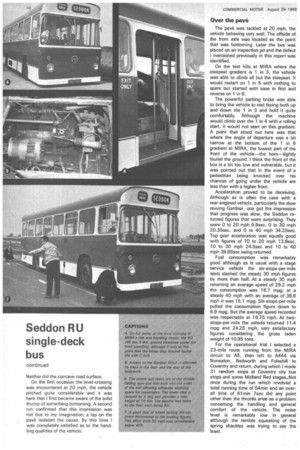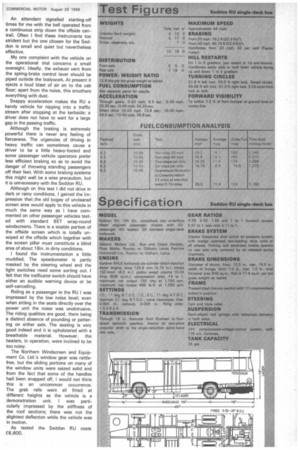Over the pave
Page 50

Page 51

If you've noticed an error in this article please click here to report it so we can fix it.
The pave was tackled at 20 mph, the vehicle behaving very well. The offside of the front axle was located as the point that was bottoming. Later the bus was placed on an inspection pit and the defect I mentioned previously in this report was identified.
On the test hills at MIRA where the steepest gradient is 1 in 3, the vehicle was able to climb all but the steepest. It would restart on 1 in 5 with nothing to spare but started with ease in first and reverse on 1 in 6.
The powerful parking brake was able to bring the vehicle to rest facing both up and down the 1 in 3 and hold it quite comfortably. Although the machine would climb over the 1 in 4 with a rolling start, it would not start on this gradient. A point that stood out here was that where the angle of departure was a bit narrow at the bottom of the 1 in 6 gradient at MIRA, the lowest part of the front of the vehicle—the horn—lightly fouled the ground. I think the front of the bus is a bit too low and vulnerable, but it was pointed out that in the event of a pedestrian being knocked over his chances of going under the vehicle are less than with a higher front.
Acceleration proved to be deceiving. Although as is often the case with a rear-engined vehicle, particularly the slow revving Gardner, one got the impression that progress was slow, the Seddon returned figures that were surprising. They were 0 to 20 mph 9.9sec, 0 to 30 mph 20.35sec, and 0 to 40 mph 34.25sec. Top gear acceleration was equally good with figures of 10 to 20 mph 13.8sec, 10 to 30 mph 24.5sec and 10 to 40 mph 39.85sec being returned.
Fuel consumption was remarkably good although as is usual with a stage service vehicle the six-stops-per-mile tests slashed the steady 30 mph figures by more than half. At a steady 30 mph returning an average speed of 29.2 mph the consumption was 16.7 mpg; at a steady 40 mph with an average of 36.6 mph it was 15.1 mpg. Six-stops-per-mile pulled the consumption figure down to 6.9 mpg. But the average speed recorded was respectable at 16.75 mph. At twostops-per-mile the vehicle returned 11.4 mpg and 24.25 mph, very satisfactory figures considering the gross laden weight of 10.95 tons.
For the operational trial I selected a 23-mile route running from the MIRA circuit to 45, then left to A444 via Nuneaton, Bedworth and Foleshill to Coventry and return, during which I made 31 random stops at Coventry city bus stops and some Midland Red stages, Not once during the run which involved a total running time of 54min and an overall time of 61 mm 7sec did any point other than the throttle arise as a problem concerning the handling and general comfort of the vehicle. The noise level is remarkably low in general although the terrible squeaking of the spring shackles was trying to say the least. An attendant signalled starting-off times for me with the bell operated from a continuous strip down the offside cantrail. Often I find these instruments too strident but the one chosen for the Seddon is small and quiet but nevertheless effective.
My one complaint with the vehicle on the operational trial concerns a small oversight. Ideally, the exhaust vent from the spring-brake control lever should be piped outside the bodywork. At present it ejects a loud blast of air on to the cab floor; apart from the noise, this smothers everything with dust.
Snappy acceleration makes the RU a handy vehicle for nipping into a traffic stream after stopping at the kerbside; a driver does not have to wait for a large gap in the passing traffic.
Although the braking is extremely powerful there is never any feeling of fierceness. The urgencies of driving in heavy traffic can sometimes cause a driver to be a little heavy-footed and some passenger vehicle operators prefer less efficient braking so as to avoid the danger of throwing standing passengers off their feet. With some braking systems this might well be a wise precaution, but it is unnecessary with the Seddon RU.
Although on this test I did not drive in dark or rainy conditions, I gained the 'impression that .the old bogey of uncleared screen area would apply to this vehicle in much the same way as I have commented on other passenger vehicles tested with standard BET wrap-round windscreens. There is a sizable portion of the offside screen which is totally unwiped at the offside which together with the screen pillar must constitute a blind area of about 18in. in dirty conditions.
I found the instrumentation a little muddled. The speedometer is partly masked by the steering wheel and the light switches need some sorting out. I felt that the trafficator switch should have either an audible warning device or be self-cancelling.
Riding as a passenger in the RU I was impressed by the low noise level; even when sitting in the seats directly over the power unit the noise was unobtrusive. The riding qualities are good, there being a distinct absence of pounding or patter ing on either axle. The seating is very good indeed and it is upholstered with a breathable material. However, the heaters, in operation, were inclined to be too noisy.
The Northern Windscreen and Equipment Co. Ltd.'s window gear was rattle free, but the sliding portions on many of the window units were seized solid and from the fact that some of the handles had been snapped off, I would not think this is an uncommon occurrence. The grab rails were all fitted at different heights as the vehicle is a demonstration unit. I was particularly impressed by the stiffness of the roof sections; there was not the slightest deflection while the vehicle was in motion.
As tested the Seddon RU costs £6,600.




































































































